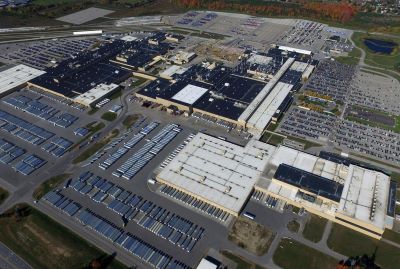Boosting productivity will require capital spending increases, more businesses using advanced technologies

Carter McCormack is with the Strategic Analysis, Publications and Training Division, Analytical Studies and Modelling Branch, at Statistics Canada. Weimin Wang is with the Economic Analysis Division, Analytical Studies and Modelling Branch, at Statistics Canada. This article, which has been edited from its original version, first appeared here.
Canada’s real Gross Domestic Product per capita has declined in five of the past six quarters and is currently near levels observed in 2017 – with recent research highlighting its negative implications for living standards and wage growth.
The declines in per capita output have also brought concerns over Canada’s weak productivity performance to the fore, since historically much of the long-term growth in GDP per capita has reflected sustained improvements in labour productivity.
Real GDP grew 1.1 per cent in 2023, its slowest annual pace since lower oil prices weighed on growth in 2016, excluding the COVID19 pandemic-related decline in 2020.
While the pace of economic activity has slowed, Canada’s population continued to expand rapidly. During 2023, Canada’s population grew 3.2 per cent, an increase of over 1,271,000 people (roughly equivalent to the size of Calgary).
With population growth outpacing output growth, GDP per capita has trended lower and is now 2.5 per cent below pre-pandemic levels.
While trends in GDP per capita yield valuable insights into changes in average incomes, they do not capture other dimensions of socioeconomic progress, including changes in income inequality or environmental sustainability. It is important to examine GDP per capita along with other indicators when conducting comprehensive assessments of economic and social well-being.
Since 1981, real GDP per capita in Canada has grown at an average annual rate of 1.1 per cent, increasing from about $36,900 per person to $58,100 per person in inflation-adjusted dollars, according to the reports.
The shock of the COVID-19 pandemic, coupled with falling per capita output in recent quarters, has left real GDP per capita 7 per cent below its long-term trend, equating to a decline of about $4,200 per person. To return to its pre-pandemic trend over the next decade, GDP per capita would need to grow at an average annual rate of 1.7 per cent per year.
Per capita growth of this magnitude is ambitious and a marked departure from recent trends.
Such growth would be qualitatively similar to the 1.6-per-cent growth in GDP per capita that the U.S. has experienced since the onset of the pandemic. In 2023, real GDP in the U.S. grew by 3.3 per cent, vastly outpacing the 0.5-per-cent increase in the population, which is just now rebounding to pre-pandemic norms.
Canada has experienced extended periods of strong per capita growth in the past. From late 1991 to 2001, GDP per capita advanced at an average annual rate of 2.2 per cent. This coincided with sustained improvements in labour productivity, bolstered by the implementation of the Canada-U.S. Free Trade Agreement and the widespread adoption of information and communication technologies.
Ways to improve real GDP per capita
Improvements in real GDP per capita can come from three sources – increases in labour productivity (a measure of how efficiently workers transform inputs into output); work intensity (the number of hours worked per employee); and the employment-to-population ratio (the percentage of the population that is working).
Of the three, improvements in labour productivity are critical, since they accounted for 93 per cent of the growth in GDP per capita over the four decades preceding the pandemic.
Structural trends in the labour market related to work intensity and population aging suggest that [labour] productivity will remain the key driver of GDP per capita in the post‑pandemic era.
Improvements in productivity will require sustained increases in capital spending. Recent research found that the amount of fixed capital invested per worker was the most important source of labour productivity growth over the past 30 years.
After increasing during the 1990s until 2006, investment per worker began to decline, especially after the collapse in commodity prices in 2014 and 2015.
As of 2021, investment per worker in business sector industries was about 15 per cent lower than in 2006. Weaker competition between firms following the mid-2000s – through rapidly decreasing firm entry rates – further limited the amount of investment spending per worker, accounting for 30 per cent of the decline.
Research also shows that higher levels of market power in the information and cultural services industry in Canada, an industry group that includes telecommunications, have contributed significantly to the productivity gap between Canada and the U.S. Eliminating market power associated with limited competitive intensity has the potential to increase investment, technical progress and innovation, according to this research.
Spending on machinery and equipment is down, investing in real estate is up
Other studies have also stressed the productivity-enhancing effects of capital investment as a way of addressing declines in Canada’s GDP per capita. BMO Economics notes the extended declines in private investment in machinery and equipment (M&E) following the onset of lower commodity prices in 2014 and 2015, with real spending on M&E currently remains below levels in 2008.
Since investment levels pulled back in the mid-2010s, GDP per capita growth has averaged 0.1 per cent per year. Other research has found that real estate has been increasingly attractive to investors since the mid‑2000s, further detracting from M&E outlays, which, in nominal terms, are currently around two-fifths of the level of real estate investment.
As rapid population expansion continues to impact housing affordability and supply, the current focus on residential investment can be expected to weigh on M&E outlays in the near term.
While capital outlays are important for economic growth, the pace of population growth warrants particular emphasis in the current context, especially when comparing current trends in GDP per capita with Canada’s past experience. The pace of population growth from 1991 to 2001, when GDP per capita was above its long-term trend, averaged one per cent, about one-third of its current pace.
Based on long-run projections from 2021 to 2060, the Organisation for Economic Co-operation and Development predicts Canada will have the lowest growth in GDP per capita of all member countries.
Attracting higher levels of capital investment to spur productivity growth and lowering market-related barriers that limit innovation and competition may help bolster output growth and partly offset potential declines in relative living standards.
Harnessing new competitive technologies will be critical
There are many open questions about the types of business investment that will lead to sustained improvements in productivity.
Traditional sources of capital investment are shifting. From 2006 to 2021, the share of intangible assets such as software and data as a portion of total fixed assets on firms’ balance sheets rose from 8 per cent to 17 per cent. These intangible assets may prove to be important sources of productivity growth in the near term.
Industries that relied heavily on digital technologies were much more resilient during the pandemic, with higher digital intensity in finance and wholesale trade industries contributing to productivity gains during the recovery period. The widespread adoption of digital services, accelerated by the pandemic, may bring about large-scale improvements in productivity similar to those that arose from the adoption of information and communication technologies in the 1990s.
The ability of Canadian companies to harness the benefits of new competitive technologies related to artificial intelligence, robotics and digitalization will be critical to the link between investment and productivity in the coming years and potentially important contributors to changes in living standards.
R$
Events For Leaders in
Science, Tech, Innovation, and Policy
Discuss and learn from those in the know at our virtual and in-person events.
See Upcoming Events
You have 0 free articles remaining.
Don't miss out - start your free trial today.
Start your FREE trial Already a member? Log in
By using this website, you agree to our use of cookies. We use cookies to provide you with a great experience and to help our website run effectively in accordance with our Privacy Policy and Terms of Service.





